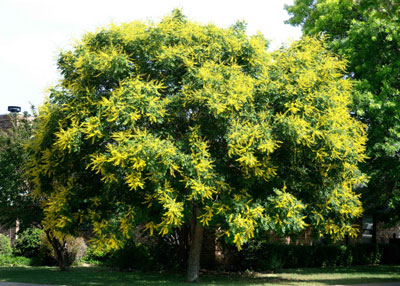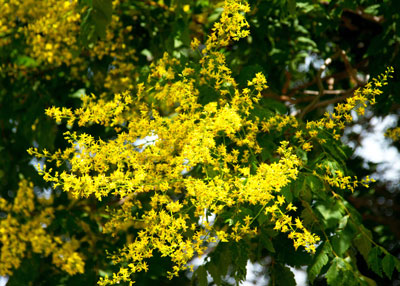The Glitter of Gold

Golden raintree and I go back four decades, and it all began for me in an old nursery in North Fort Worth.
We’d just moved into our new house outside McKinney. We had (have) 11 acres, some of it wooded but some of it open.
I’d made a list of the unusual shade trees I wanted to plant. Golden raintree was the one I was having the most trouble finding. Finally, a historic old nursery answered their phone and the owner said, “Yep. We got ‘em. 12 feet tall. 5-gallon cans.”
I was so excited I hopped into my truck and headed 65 miles across DFW. Plant guys do silly things like that. But I wondered, as I drove there, what kind of shape those golden raintrees would be in. The numbers seemed pretty skewed – 12 feet is awfully tall for a 5-gallon pot.
And yes, you’re way ahead of me, and you’re absolutely correct. Those trees were firmly rooted into the soil. And they had been so for a year or two, it appeared. It was June, and they were growing vigorously. They had roots out their drain holes and 2 feet into the ground. But desperate to find my tree, I bought one and asked that it be uprooted and trimmed to compensate for the crisis I was causing it.
I repotted it immediately when I got home, and it spent several months recovering as we finished construction of our house. It came back just fine, and it performed wonderfully – until our giant pecan trees shaded it out. But it served me faithfully for the 30 years that I had it.

Here are your facts…
• Golden raintree Koelreuteria paniculata
• Golden raintrees are native to northern China and Korea.
• They’re perfect as the second or third trees in an urban landscape, because they grow to a reserved 25 or 30 feet tall and wide at maturity.
• They’re good near patio homes, in side yards and medians – anywhere you’d like a medium-sized, dependable shade tree.
• They’re suited to a wide variety of soils, and they handle hot and dry weather quite well.
• Like any drought-tolerant tree, they will grow better when they’re kept uniformly moist.
• Apply the same fertilizer to your golden raintree that you would to your turfgrass and shrubs. For most of us, that’s going to be a high-quality, all-nitrogen fertilizer with half or more of its nitrogen in slow-release form.
• As an added bonus on really special years, golden raintrees’ leaves may show really nice fall color.
Another type for warmer areas…
Those of you along the Gulf Coast of Texas have access to another, much less winter-hardy species of the same genus. Koelreuteria bipinata is the southern golden raintree. It, too, produces the bright yellow blooms, but they’re followed by showy pink “lanterns” of fall fruit that are almost as eye-catching as the flowers.
